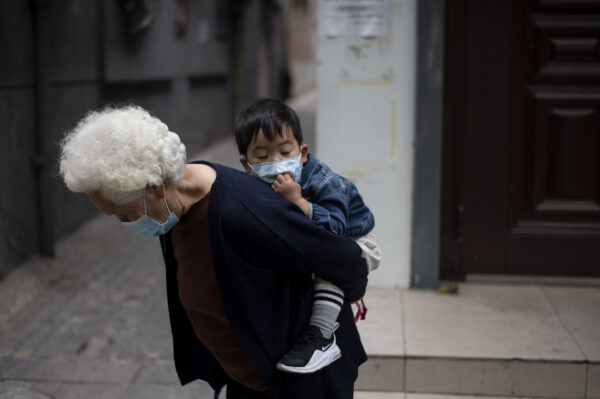Economic Impact of an Aging China
Commentary China’s population drop will coincide with an economic contraction. For the first time since 1961, the Chinese population is in decline. This year, India is climbing to the position of the world’s most populous country, relegating China to second place. With a smaller population and a slowing economy, China achieving its global ambition of surpassing the United States is now even more remote. The birth rate last year was at a record low of 1.18 children per mother, which is well below the “replacement rate” of 2.1 children per mother. Falling birth rates have led to both a diminishing and a rapidly aging population that is inching China closer to a demographic crisis. Last year, it was estimated that the Chinese population shrank by 850,000 people. Twenty percent of China’s population is already over the age of 60, and by 2035, the total number of seniors is expected to be 400 million. This would be nearly one-third of the population. Correcting a falling birth rate is not easy, and no country has ever succeeded in doing so. Countries like Finland, Estonia, Italy, Japan, Australia, and Hungary have offered citizens cash bonuses for having additional children to no avail. The costs of additional children outweigh even the most generous allowances given by the government. China’s problem is exacerbated because it is among the top six countries with the most imbalanced gender ratio. Historically, Chinese people have preferred sons over daughters. The one-child policy introduced in 1980, combined with liberal abortion rules, has led to the birth of more boys than girls. United Nations data shows that between 1970 and 2020, China alone accounted for 51 percent of a global gender imbalance, or “missing” females. In 2015, when the one-child policy was changed to a two-child policy, birth rates increased slightly, but not nearly enough to reverse the trend of population decline. Additionally, families still prefer boys. In 2021, the birth ratio was 112 boys to 100 girls. In the same year, China already had 30 million more men than women. An elderly woman is piggybacking a boy along a street in Beijing on May 11, 2020. (Noel Celis/AFP via Getty Images) Immigration saved the United States from falling into a similar aging crisis. Immigrants tend to be young working people who marry and start a family after getting settled, or they immigrate with their families. Many come from countries where families have more than two children, which helps to keep America’s age demographics balanced. However, there is almost no immigration into China to help with balance. In 2021, 813,861 immigrants became naturalized U.S. citizens. By contrast, naturalization in China is nearly impossible, with the exception of citizens from Taiwan, Hong Kong, and Macau, as well as people of Chinese descent who can demonstrate that they have family living in China. In most years, the total number of applications for naturalization is generally around 1,500, with most of these coming from Hong Kong. To make matters worse, hundreds of thousands of Chinese leave the country each year. In 2021, when China and many other countries still had strict COVID-19 restrictions, 200,000 Chinese emigrated. And under non-COVID conditions, the average is about 300,000 per year. After three years of lockdowns and Chinese leader Xi Jinping’s tightened grip on the economy, even more Chinese are in the process of leaving this year. And many of these are the best and brightest young people with excellent qualifications or successful business people with investment capital. The outflow of young people will further contribute to China’s demographic imbalance. It will also decrease the size of China’s workforce. The loss of entrepreneurs and the wealthy will reduce the amount of investment capital and know-how, making an economic recovery even less likely. Last year, China’s GDP growth of only 3 percent was the worst in decades. As the population ages, there are fewer workers to contribute to GDP. Additionally, older people are less likely to buy things like new homes or cars, so consumption is expected to contract. But more pensioners and elderly who need care will increase the tax burden spread over a smaller working population. Countries like Japan, Germany, and South Korea have been able to manage their diminishing young population by increasing their development of technology, which allows more work to be done by fewer people. But China is far behind those countries in technological development, and its innovation will suffer with its most qualified engineers leaving for careers in the West. Views expressed in this article are the opinions of the author and do not necessarily reflect the views of The Epoch Times.

Commentary
China’s population drop will coincide with an economic contraction.
For the first time since 1961, the Chinese population is in decline. This year, India is climbing to the position of the world’s most populous country, relegating China to second place. With a smaller population and a slowing economy, China achieving its global ambition of surpassing the United States is now even more remote.
The birth rate last year was at a record low of 1.18 children per mother, which is well below the “replacement rate” of 2.1 children per mother. Falling birth rates have led to both a diminishing and a rapidly aging population that is inching China closer to a demographic crisis. Last year, it was estimated that the Chinese population shrank by 850,000 people. Twenty percent of China’s population is already over the age of 60, and by 2035, the total number of seniors is expected to be 400 million. This would be nearly one-third of the population.
Correcting a falling birth rate is not easy, and no country has ever succeeded in doing so. Countries like Finland, Estonia, Italy, Japan, Australia, and Hungary have offered citizens cash bonuses for having additional children to no avail. The costs of additional children outweigh even the most generous allowances given by the government.
China’s problem is exacerbated because it is among the top six countries with the most imbalanced gender ratio. Historically, Chinese people have preferred sons over daughters. The one-child policy introduced in 1980, combined with liberal abortion rules, has led to the birth of more boys than girls. United Nations data shows that between 1970 and 2020, China alone accounted for 51 percent of a global gender imbalance, or “missing” females. In 2015, when the one-child policy was changed to a two-child policy, birth rates increased slightly, but not nearly enough to reverse the trend of population decline. Additionally, families still prefer boys. In 2021, the birth ratio was 112 boys to 100 girls. In the same year, China already had 30 million more men than women.

Immigration saved the United States from falling into a similar aging crisis. Immigrants tend to be young working people who marry and start a family after getting settled, or they immigrate with their families. Many come from countries where families have more than two children, which helps to keep America’s age demographics balanced. However, there is almost no immigration into China to help with balance.
In 2021, 813,861 immigrants became naturalized U.S. citizens. By contrast, naturalization in China is nearly impossible, with the exception of citizens from Taiwan, Hong Kong, and Macau, as well as people of Chinese descent who can demonstrate that they have family living in China. In most years, the total number of applications for naturalization is generally around 1,500, with most of these coming from Hong Kong.
To make matters worse, hundreds of thousands of Chinese leave the country each year. In 2021, when China and many other countries still had strict COVID-19 restrictions, 200,000 Chinese emigrated. And under non-COVID conditions, the average is about 300,000 per year. After three years of lockdowns and Chinese leader Xi Jinping’s tightened grip on the economy, even more Chinese are in the process of leaving this year.
And many of these are the best and brightest young people with excellent qualifications or successful business people with investment capital. The outflow of young people will further contribute to China’s demographic imbalance. It will also decrease the size of China’s workforce. The loss of entrepreneurs and the wealthy will reduce the amount of investment capital and know-how, making an economic recovery even less likely.
Last year, China’s GDP growth of only 3 percent was the worst in decades. As the population ages, there are fewer workers to contribute to GDP. Additionally, older people are less likely to buy things like new homes or cars, so consumption is expected to contract. But more pensioners and elderly who need care will increase the tax burden spread over a smaller working population. Countries like Japan, Germany, and South Korea have been able to manage their diminishing young population by increasing their development of technology, which allows more work to be done by fewer people. But China is far behind those countries in technological development, and its innovation will suffer with its most qualified engineers leaving for careers in the West.
Views expressed in this article are the opinions of the author and do not necessarily reflect the views of The Epoch Times.












